Understanding the Ballroom Culture & Its Incredible Impact on the World!

Often referred to with terms like Ball culture, drag ball culture, the house-ballroom community. The ballroom scene or ballroom culture, a young African-American and Latin American underground Queer subculture that originated in New York City, in which people “walk” (i.e., compete) for trophies, prizes, and glory at events known as balls. This winning was the simple yet revolutionary beginning of the ballroom culture to become a countercultural phenomenon!
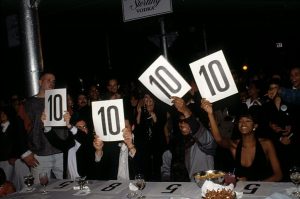
The ballroom scene consists of events that mix performance, dance, lip-syncing, and modelling. Events are divided into various categories, and participants “walk” for prizes and trophies. As a countercultural phenomenon, the ballroom is rooted in necessity and defiance. In the late nineteenth century, members of the underground LGBTQ+ community in large cities began to organize masquerade balls known as “drags” in defiance of laws that banned individuals from wearing clothes associated with the opposite gender.
From pop and R&B hits to RuPaul’s Drag Race, vogue and ballroom’s cultural visibility in the mainstream has come a long way from the 1980s New York City underground scene.
Participants were and are mainly young African-American and Latin American members of the LGBTQ community. Although some balls were integrated, the judges were always white, and African-American participants were often excluded from prizes or judged unfairly.
Houses in the Ballroom Culture
In the early 20th century, African Americans and Latinos started their balls. Ball culture then grew to include primarily gay, lesbian, bisexual, and Trans Black people and Latinos. To Participate in the ballroom competitions, one must belong to a House.
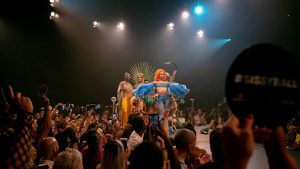
Houses serve as alternative families, primarily consisting of Black and Latino LGBT individuals, and are meant to provide shelter, solace and safety for those who have often been kicked out of their original homes due to being LGBT. These houses are led by “mothers” and “fathers” who are usually older members of the ballroom scene, who are typically drag queens, gay men or transgender women, who provide guidance and support for their house “children”.The children of a House are each other’s “siblings.”
Historically, four categories of gender have existed within houses:
- Butch queens – A gay male who is neither extremely masculine nor highly feminine but has the mannerisms of both
- Femme queens – A term originating in the LGBT ballroom community, meaning any male that takes hormones and/or has sexual re-assignment and lives and as women and appears to be a woman daily.
- Butches- a lesbian whose appearance and behaviour are seen as traditionally masculine.
- Women – Cis-gendered women
Houses that win a lot of trophies and gain recognition reach the rank of legendary, and Typically, house members adopt the name of their house as their last name. Here are some of the most famous houses in the ballroom culture:
- The House of Ebony (founded by Richard and Larry Ebony)
- The House of Ninja (founded by Willi Ninja)
- The House of Aviance (founded by Mother Juan Aviance)
- The House of Xtravaganza (founded by Hector Valle, and chiefly run by Hector Xtravaganza and Angie Xtravaganza in the 1980s)
- The House of Princess
- The House of Infiniti
- The House of Mizrahi (founded by Andre, Jack, and Heidi Mizrahi)
- The House of Gucci (Founded by Father Dr Will Gucci and Mother Meechie Demetrius) (1995)
- The House of LaBeija (founded by Crystal LaBeija, and chiefly run by Pepper LaBeija in the 1980s and 1990s)
- The House of Dupree (founded by Paris Dupree)
- The House of Aphrodite (founded by Ira Ebony, Latisha Revlon, and Dwayne Mugler)
- The House of Amazon (founded by Leoimy Maldonado)
- The House of Mugler (founded by David, Raleigh and Julian)
- The House of Balenciaga (founded by Harold Balenciaga)
- The Iconic House of Khan (founded by Lowell Khan)
- The House of Lanvin (founded by Kenny Evisu and Meechie Lacroix)
- The House of Garcon.[17] (founded by Whitney and Shannon Garcon)
- The Iconic House of Allure (founded by Al Allure & Okio Allure)
- The Iconic House of St. Laurent (Founded by Robbie, Chris & Terry St. Laurent)
- The Iconic House of Prodigy (founded by Mann Prodigy)
- The House of Balmain (founded by Rodney Balmain)
- The Iconic House of Revlon (founded by Tony Revlon)
- The Iconic House of Icon (founded by James Icon)
- The House of West
Influences on Pop culture
New York’s ballroom culture has had a highly significant cultural impact from the 1980s to the present day. Undoubtedly, the ballroom culture had a massive influence on the pop culture of our day, from fashion to music to popular slang, breaking boundaries beyond just the queer community. And it is essential to remember the black and Latinxs queer community that contributed so significantly to the culture. Ballroom culture prevails and will continue to – just last year, the MET Gala’s theme ‘camp,’ pulled directly from the fashion and ways of expressions born of ballroom culture.
Dance
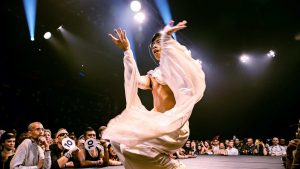

Ballroom dance is consistently transforming itself. From its earliest form in the late sixteenth century, the ballroom has continued to grow and evolve into today. To avoid extinction, the ballroom has relied on new developments and fresh characteristics. This can already be seen in the previous historical account of ballroom and its transformation from old-time to modern. Each new step in that transformation drew from various cultural traditions, from the Waltz with its roots in southern German folk songs and the Foxtrot with its rhythms of African origin. The numerous Latin American traditions, such as Brazilian Samba, and Cuban Salsa, Rumba, and Mambo, have gained popularity within the ballroom.
The most notable influence of ballroom culture on mainstream society is Voguing, a dance style originating in Harlem ballrooms during the latter half of the 20th century and appropriately showcased in the video for Madonna’s “Vogue,” released in 1990 (a year before the documentary Paris Is Burning).
Named after Vogue magazine, Voguing required dancers to mirror the poses held by models, emphasizing arm and hand movements. Dancers would play out elaborate scenes such as applying makeup or taking phone calls while dancing down the catwalk. Dancer and choreographer Willi Ninja have been recognized as the “Grandfather of Vogue”, and the dance and Ninja himself were covered in the documentary Paris is Burning.
Language

The language of the ballroom scene has exploded into mainstream culture like never before. The legacy of ball culture on current drag is extensive. The language that grew out of it is shared among the LGBTQ+ community as a whole (such as terms “reading” and “shade”, meaning insults used in battles of wit, and “spilling tea” meaning gossiping). The use of categories and judging can be seen on popular reality TV programs such as RuPaul’s Drag Race.
Everyone loves to throw shade, read, vogue, and dip all day. RuPaul’s 1993 hit song “Supermodel (You Better Work)” had even middle-aged white suburbanites saying “Work!” That expressive lexicon still sashays from the lips of today’s RuPaul’s Drag Race contestants: “Yas, queen! Sissy that walk!”
The terms of Ballroom culture are sometimes used more generally; “drag mother” may apply to any drag queen in a mentorship role, and “drag house” may refer to a group of drag performers allied personally or professionally. “Fierce” and “fierceness,” “work it” and “working it,” “fabulous” and “fabulousness” are heard in Paris Is Burning.
Music
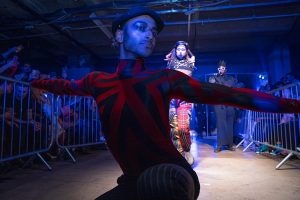
A key element of balls is the music, which is typically characterized by distinct, up-tempo beats that are overlaid with the “raps” of commentators or emcees. Lyrics are just as stylish as the beats and often praise queerness and femininity. “It’s more than music — it’s an attitude,” says Niall Connolly, a U.K. ballroom DJ who goes by CVNT TRAXXX. “Society says you’re worthless, but the music says no — that’s a great thing, and you’re not alone.”
Historically, the music featured at balls has been whatever is popular within the black Queer community at the time, ranging from disco to club music, to house, and now even rap and R&B. House music, the primary sound of the balls, is always upwards of 120 beats per minute and has African roots, which is reflected in the rhythm.
Today, it is common for older house classics like “Work This Pussy” by Ellis D and “Cunty” by Kevin Aviance to be remixed into new hits by the current wave of DJs and producers. Overall, ball culture has been fertile ground for new forms of house music and other genres of electronic dance music through its DJs. The culture has also influenced a wave of queer hip hop artists such as Zebra Katz, House of Ladosha and Le1f.
Fashion
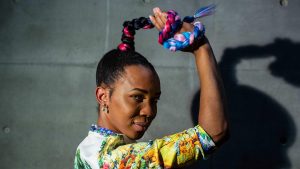
The Ballroom culture has influenced “the über-puffed-up peacock sexuality” of contemporary mainstream hip hop. A professor at New York University said “Today’s queer mania for ghetto fabulousness and bling masks its elemental but silent relationship to even more queer impulses toward fabulousness in the 1980s.”
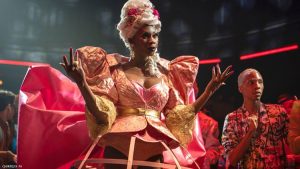
It has been the foundation of mainstream fashion for decades, influencing modern TV shows from RuPaul’s Drag Race to the Emmy Award-winning show Pose. Yet ballroom-inspired fashion is not a new phenomenon.
Now and the Future

In September 2006, Beyoncé told a reporter from The Independent “how inspired she’s been by the whole drag-house circuit in the States, an unsung part of black American culture where working-class gay men channel ultra-glamour in mocked-up catwalk shows. ‘I still have that in me’, she says of the ‘confidence and the fire you see on stage…'”[63]
In 2020, the voguing reality competition web series Legendary premiered on the HBO Max streaming service. The series follows members of eight prominent houses as they navigate their way through nine balls (dancing, voguing, etc.), with a $100,000 prize awarded to the winner.
Ballroom culture has been the foundation of mainstream fashion for decades, influencing modern TV shows from RuPaul’s Drag Race to the Emmy Award-winning show Pose. It is futuristic and its power lies in the ability to evolve while still maintaining its roots.
Have you ever been to a ballroom? Would you like to? Let us know in the comments below! Also, check out my take on ‘Is LilNas the New leader of the Gen Z Pop Culture World?’!
Sources:
Sarah G., Smith C. (2012,May 2nd) Ballroom: The Dance That Globalization Built https://sophia.smith.edu/blog/danceglobalization/2012/05/02/ballroom-the-dance-that-globalization-built-2/
Max, M. (2018, November, 10) Here’s everything you need to know about the ballroom scene https://www.redbull.com/za-en/guide-to-ballroom-vogue-scene
Davis, C. (2021, March 9) The Language of Ballroom https://glreview.org/the-language-of-ballroom/
Bailey, M. “Gender/Racial Realness: Theorizing the Gender System in Ballroom Culture”. Feminist Studies. 37: 365–386.
Wilson, J (2010, August 4). Bulldaggers, Pansies, and Chocolate Babies. University of Michigan Press.
Stuart, B (2011, January 1,). Voguing and the house ballroom scene of New York City 1989-92. ISBN 9780955481765. OCLC 863223074.
Luce, CA. (2020, November 10) Ballroom Culture’s Influence on Modern Fashion https://berkeleyhighjacket.com/column/ballroom-cultures-influence-on-modern-fashion/#:~:text=Ballroom%20has%20provided%20opportunities%20for,off%20unique%20garments%20and%20pieces.&text=Ballroom%20culture%20has%20been%20the,Emmy%20Award%20winning%20show%20Pose.
Ballroom picture – Picture by DREW GURIAN- Vogue Ball at Red Bull Music Festival NYC in 2014 https://www.redbull.com/za-en/guide-to-ballroom-vogue-scene
Dip” entry featuring Leiomy Maldonado from The Queen’s English, art by Troy Lambert https://glreview.org/the-language-of-ballroom/
“Vogue” entry from The Queen’s English, art by Troy Lambert https://glreview.org/the-language-of-ballroom/
Photography by David, M (@dcmorr) (2018, September24th) Get to know the UK Ballroom scene, from the voguers at its heart https://www.dazeddigital.com/fashion/article/41417/1/ballroom-scene-voguing-gareth-pugh-judy-blame-ball-london-fashion-week-ss1







